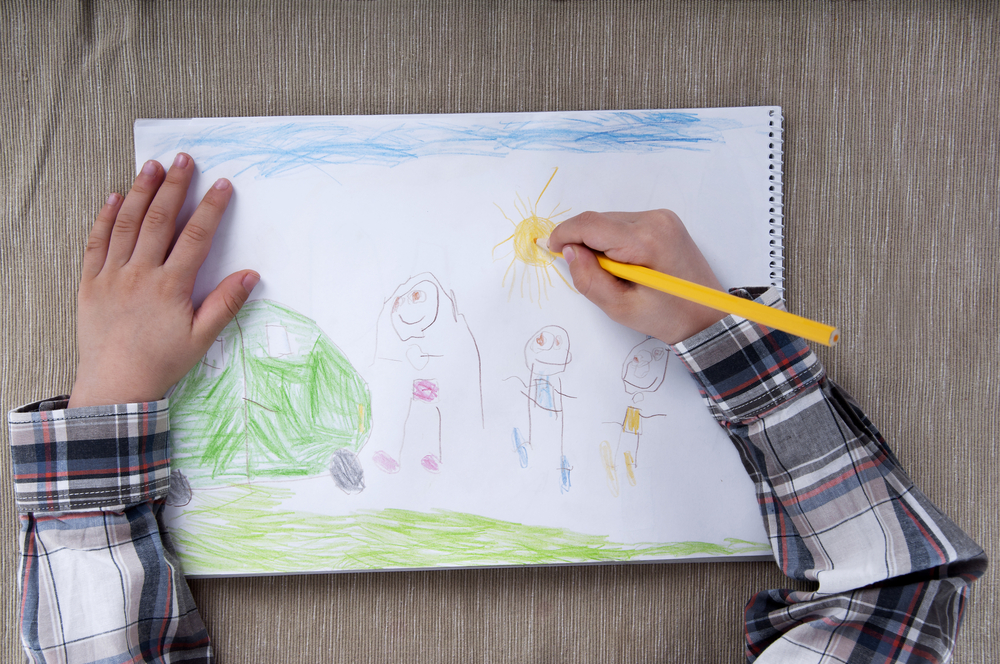
I have written a few times about how important creativity is for children’s development. This time around I am going to demonstrate how early drawing experiences can help young children become thoughtful, critical readers and writers.
In preschool, introducing writing tools has always been a big part of my curriculum. Children as young as 18 months can begin the formation of their pincer grasp, which helps them to hold a crayon or marker. This can be encouraged early on through the use of many fine muscle activities in addition to experimenting with writing tools.
My preschoolers, beginning in our classroom of ages two and a half to five, would have the opportunity to work with crayons, markers, pens, and pencils, with plenty of paper available. This “Writing Table” was available throughout the day, with children producing anything from scribbles to pretend grocery lists to intricate drawings. Some children would come to me already knowing how to use these writing tools while others might be just discovering them.
Research has found that children who engage deeper in this read aloud process and are also encouraged to draw freely are the same students that end up successfully writing their own stories early on and are often ahead on the reading/writing continuum.
I will never forget meeting a little boy who was already around four years old and about to enroll in preschool. During a home visit, I asked him to draw me a picture. His parents preempted this activity by ascertaining that “he doesn’t do art.” And, as they predicted, this child picked one blue marker from the box and drew one blue line and said, “here.” Once he spent time in my classroom, after busying himself each day with block play or toy cars with his friends, he would visit the Writing Table. I would often sit there with the children and ask them questions about their drawings. I cannot remember what initially inspired this boy, but suddenly he began drawing very detailed trucks that represented his father’s business. By the end of the year he spent more time at the Writing Table than at the blocks and his drawings grew to include more and more details, like the driver and some lettering on the truck.
Clearly this child, who previously seemed uninterested in “art activities,” actually just needed the right opportunity to discover the power of the picture. Drawing pictures, for young children, is their first pathway towards symbolic communication. In essence, it is their precursor to writing. Exposed to picture books at early ages, young children view a story as pictures.
Knowing all of this, how we go about reading to our children in addition to supporting their drawing development can make a difference in the acquisition of literate abilities. When I read to a group of children, they often ask questions and make comments. Some may view this as interruption, but actually, it is a sign that those children are paying attention to the content of the story. Allowing a pause in a story can elicit what some folks call “book talk” where children might pose a different action in a story or wonder at the behavior of a character (Goldilocks and the Three Bears is a great one for this!).
Research has found that children who engage deeper in this read aloud process and are also encouraged to draw freely are the same students that end up successfully writing their own stories early on and are often ahead on the reading/writing continuum. Scholar Ann Dyson coined the phrase “symbol weaving” around 1986 to validate children’s use of pictures as an important communicative symbol system in its own right and as an integral part of the development of literate ability. Symbol weaving names the mutually supportive systems of talking, drawing and producing beginning text.
As children grow, they begin to connect the idea of the written word in harmony with pictures. When I taught a combined classroom of kindergarten, first, and second graders, drawing a picture to get started with our writing was a common ritual.
Encourage the scaffolding of these skills at home by reading quality picture books early on and providing writing tools as soon as one year. This can be messy, so set up an area appropriately, maybe create your own Writing Table space! Toddlers begin their writing experiences very kinesthetically, sometimes banging crayons or markers until they are broken, but that is normal until they mature further.
If you would like suggestions for good picture books to read to your child or activities to develop early acquisition of the pincer grasp, feel free to email me at Jill@DenverNorthStar.com.
Jill Carstens taught for 30 years and now enjoys writing this column, connecting with North Denver merchants for ad sales for The Denver North Star and organizing neighborhood events supporting the local arts, community and sustainable ideas.

Be the first to comment